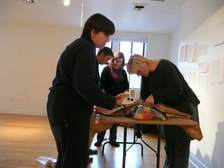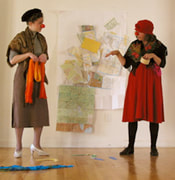|
Expressive arts therapy (EXA) is a way of using the arts to help people with psychological or other problems. EXA assumes that everyone has the capacity to respond creatively to the situations that they find themselves in. By engaging in play and the arts, we are taken into the world of the imagination, where possibilities can be seen that are not evident in our daily lives. We can find resources that we did not know we had and possible solutions that were previously hidden from us. Instead of focusing on deficiencies and dwelling on problems, the EXA approach is resource-based and solution-focused.
The practice of the arts is an activity that involves the senses and the emotions. In an EXA session, we not only talk about our difficulties, we actively engage in artistic practices that give us a bodily and emotional relationship to what we are going through. The EXA therapist helps her clients by setting challenges within the arts that they can meet; clients thereby gain a sense of the abilities they have that can be used to solve their problems in daily life. |
TheoryEXA therapists use a “low-skill high-sensitivity” approach. This means that clients do not have to be artists or have any particular artistic ability; they can be helped to become sensitive to whatever they are experiencing, whether they are engaged in play, movement, vocal expression, sound-making, work with colours and shapes, dramatic action and other forms of expression. The EXA therapist sensitizes her clients to the materials they are using and helps them to engage creatively in whatever medium they choose.
|
|
EXA is an interdisciplinary or “intermodal” form of art therapy. All the modalities of the senses may be involved and all the artistic disciplines can be drawn upon – music, dance, drama, visual art, writing, etc. Beginning with a playful attitude, the EXA therapist helps her clients find a way of working with their chosen materials that feels “just right” to them.
EXA sessions are collaborative; client and therapist work together to find solutions that are helpful. The relationship of the therapist and client is crucial. We sometimes say that the client is the “expert,” since she knows her own life and her own problems better than we ever can, and that the therapist is the “companion,” since she is there to be with the client, not to diagnose or fix them. |
Expressive arts therapy is a new and exciting field of therapeutic practice. It emphasizes creative expression in all its forms within a collaborative process in which both therapist and client are engaged. People who engage in EXA can become aware of abilities that they did not know they had, and gain a renewed sense of their own vitality. They can then face the difficulties of living with confidence and hope.
Who can benefit from Expressive Arts Therapy?
Expressive arts therapy can be applied in a broad range of settings and with a variety of people and their difficulties. EXA therapists work in many different contexts. They may work in private practice with individuals and groups, in hospitals and agencies that focus on mental health, in shelters for women and children, in old-age homes, in hospice care and in schools. All kinds of people can engage in EXA – for example, individuals interested in personal growth work, individuals with mental health issues, the elderly, children with autism, parents, victims of abuse and those with terminal illnesses. At The Create Institute, students do their practicum work in a wide variety of settings. After graduation, some students continue as paid employees in those same settings. They can also apply the skills they have developed to engage in other kinds of work, which may involve community organization, conflict transformation, consulting, coaching and social change.
EXA in Practice
EXA at Work
|


